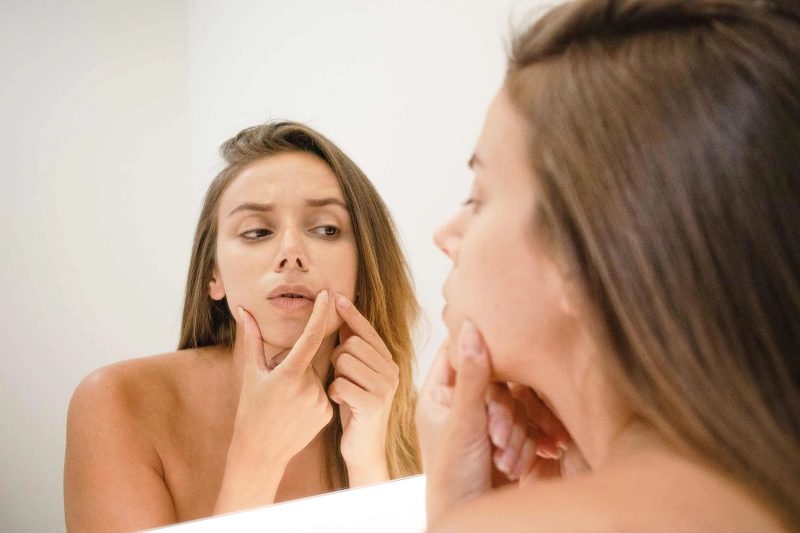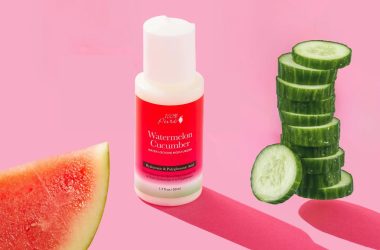Understanding the key differences, proper treatment methods, and how to build a skincare routine that works
Posted on April 27, 2025 Written by: 100% PURE®

Introduction
Many people confuse sebaceous filaments with blackheads, but treating them the same way can lead to unnecessary irritation or disappointment. This blog will help clarify the difference and share how to care for each concern using gentle, effective skincare practices backed by science.
Many people confuse sebaceous filaments with blackheads, but treating them the same way can lead to unnecessary irritation—or worse, make the problem more noticeable. This guide will clear up the confusion and show you how to care for your skin using science-backed methods and gentle, effective skincare steps. With the right approach (and a little patience), you can build a routine that works with your skin, not against it.
Understanding Your Skin: What’s Going On Inside Your Pores
Before diving into treatments, it’s important to understand what’s happening beneath the surface.
Your pores house hair follicles and sebaceous glands, which produce sebum—your skin’s natural oil. Sebum is vital for keeping skin healthy and hydrated, but when mixed with dead skin cells and environmental pollutants, it can clog pores.
This buildup can either stay open (leading to blackheads) or become part of your skin’s natural texture (appearing as sebaceous filaments). Knowing the difference helps you choose the best steps for a skincare routine that supports clear, balanced skin.

What Are Sebaceous Filaments?
Unlike blackheads, sebaceous filaments are a completely normal part of your skin’s physiology. Here’s what sets them apart:
- They appear as uniform, skin-colored or yellowish dots, often found in the T-zone where oil production is higher.
- Their role is actually helpful: they transport sebum from inside your pores to the skin’s surface, keeping your skin naturally moisturized.
- Sebaceous filaments become more visible with oily skin or when pores are enlarged, but they are not “clogs” or “dirt” that needs to be extracted like blackheads.
Trying to scrub away sebaceous filaments aggressively can irritate your skin and worsen the appearance of pores. Instead, supporting your skin’s natural oil balance is key.
Our Favorite Products to Support Sebaceous Filament Care:
-
Blood Orange Cleansing Balm
Our rich, nourishing cleansing balm helps dissolve excess oil, sunscreen, and makeup without stripping your skin. Oil cleansing can actually help balance sebum production, making sebaceous filaments less noticeable over time. -
Tea Tree Deep Detox Mask
A powerful yet gentle clay mask designed for weekly oil control. Our formula uses clarifying tea tree and detoxifying clay to help refine pores without over-drying or stressing the skin barrier. -
Apple Enzyme Resurfacing Serum
This gentle exfoliating serum uses natural fruit enzymes to promote cell turnover. It smooths and brightens your complexion while respecting your skin’s natural structure—making it a smart choice for minimizing the appearance of sebaceous filaments without harsh scrubbing.
What Are Blackheads?
While sebaceous filaments are a normal part of healthy skin, blackheads are actually a mild form of acne known as an open comedone. Here’s what sets blackheads apart:
- Blackheads form when pores become clogged with a mixture of excess oil, dead skin cells, and environmental impurities.
- Once exposed to air, the debris inside the pore oxidizes, turning a dark brown or black color—not because it’s dirty, but simply because of the chemical reaction with oxygen.
- Blackheads often feel slightly raised or uneven to the touch, and can appear more sporadically across the nose, chin, forehead, or back.
Trying to treat blackheads and sebaceous filaments the same way can backfire—leading to irritation, enlarged pores, or even more breakouts. Recognizing the difference is the first step to building an effective routine.
Key Signs to Tell Them Apart:
- Blackheads are darker, firmer, and appear more randomly across the skin.
- Sebaceous filaments are usually even in size and color, and if you try to extract them, they often return quickly—because they’re part of your skin’s natural oil flow.
Learning to spot the difference helps you choose the right steps for a skincare routine—without over-exfoliating, picking, or stripping your skin’s barrier.
How to Treat Sebaceous Filaments vs. Blackheads: What Works and What Doesn’t
Once you understand whether you’re dealing with sebaceous filaments or blackheads, you can fine-tune your routine to treat them effectively—without causing unnecessary damage.
For Sebaceous Filaments:
- Use oil-based cleansers like our Blood Orange Cleansing Balm to gently dissolve buildup without stripping your skin.
- Exfoliate 2–3 times per week with enzyme-based products like our Apple Enzyme Resurfacing Serum or a mild BHA to keep pores clear without irritation.
- Avoid pore strips and aggressive scrubbing—these can stretch and damage your pores, making sebaceous filaments even more noticeable.
- Support hydration with lightweight moisturizers and hydrating toners to keep oil production balanced and skin calm.
For Blackheads:
- Exfoliate consistently with salicylic acid (a type of BHA) to penetrate deep into pores and clear out debris.
- Incorporate retinoids (vitamin A derivatives) to encourage healthy cell turnover and reduce clogged pores over time.
- Use clay masks like our Tea Tree Deep Detox Mask to draw out impurities and minimize the appearance of blackheads.
- Consider professional extractions for stubborn blackheads—done by an experienced esthetician to avoid scarring or trauma.
No matter which concern you’re addressing, a consistent, gentle skincare routine is the key to achieving a smoother, clearer complexion without risking your skin barrier.
A Skincare Routine for Both Concerns
If you’re managing both sebaceous filaments and blackheads, the right routine can make all the difference. Here’s a simple, effective plan to support clear, balanced skin without overdoing it.
Morning Routine:
- Sake Cloud Foam Cleanser to refresh and purify without stripping essential moisture.
- Our Vitamin C Serum to brighten skin tone and defend against environmental stressors.
- Watermelon Cucumber Water Locking Moisturizer for lightweight hydration that supports healthy oil balance.
- Green Tea SPF 30 to protect your skin daily, preventing damage that can worsen pore visibility.
Evening Routine:
- Blood Orange Cleansing Balm to dissolve makeup, oil, and debris while nourishing your skin.
- Sake Cloud Foam Cleanser for a fresh, clean slate.
- Alternate nightly between:
- Apple Enzyme Resurfacing Serum for gentle exfoliation and smoother texture.
- Multi-Vitamin + Antioxidants Potent PM Serum to deeply nourish and support overnight repair.
- Watermelon Cucumber Water Locking Moisturizer to seal in hydration and calm the skin.
Weekly Treatments:
- Tea Tree Deep Detox Mask to control excess oil and purify congested pores.
- Gentle exfoliation 1–2 times per week to keep buildup at bay without over-sensitizing your skin.
Consistency is key—stick to this rhythm and adjust based on how your skin feels day-to-day.

Myths & Misconceptions
When it comes to sebaceous filaments and blackheads, misinformation can lead to frustration and wasted effort. Let’s clear up some of the biggest myths:
-
Myth: Blackheads are just dirt.
Truth: Blackheads are a mix of oxidized oil and dead skin cells—not dirt—giving them their dark color. -
Myth: You can permanently shrink pores.
Truth: While you can’t change the actual size of your pores, you can minimize their appearance with consistent care and the right skincare products. -
Myth: Scrubbing harder clears clogged pores faster.
Truth: Over-scrubbing can irritate and damage your skin. Gentle exfoliation with the right ingredients is much more effective (and safer).
Conclusion
Sebaceous filaments and blackheads may look similar, but they behave very differently—and require different care. While you can’t eliminate sebaceous filaments completely, you can minimize their appearance with the right approach. Blackheads, on the other hand, can be treated and prevented through a consistent, well-balanced skincare routine. With gentle, science-backed practices and our high-performance natural products, you can support clearer, healthier-looking skin every day.
Frequently Asked Questions (FAQs)
How can I tell if I have blackheads or sebaceous filaments?
Blackheads are darker, firmer, and often feel slightly raised, while sebaceous filaments are lighter in color (often yellowish or skin-toned), smaller, and more evenly spaced across oily areas like the nose and chin.
Will sebaceous filaments go away if I extract them?
Extracting sebaceous filaments will temporarily clear them, but they will naturally refill within days. They are a normal part of healthy skin and help transport oil to the surface.
Can I use the same products to treat both?
Some products overlap, but it’s important to adjust your approach. For sebaceous filaments, focus on gentle cleansing, hydration, and mild exfoliation. For blackheads, incorporate stronger exfoliants like salicylic acid and consider adding retinoids.
Is vitamin C good for reducing blackheads or large pores?
Yes! Our Vitamin C Serum can help brighten the skin, support healthy collagen levels, and improve overall texture, making pores and blemishes less noticeable over time.
What’s the best way to prevent clogged pores in the first place?
Stick to a consistent skincare routine that includes gentle cleansing, regular exfoliation, hydration, and daily SPF. Using oil-based cleansers like our Blood Orange Cleansing Balm can also help dissolve buildup without stripping your skin.









